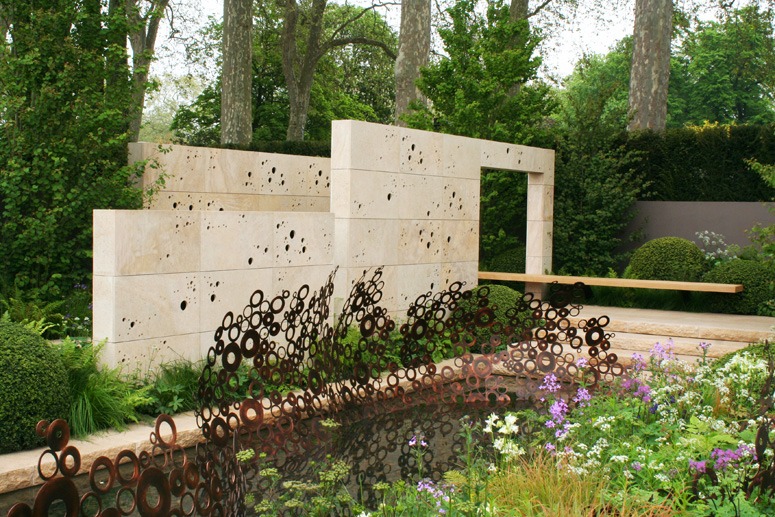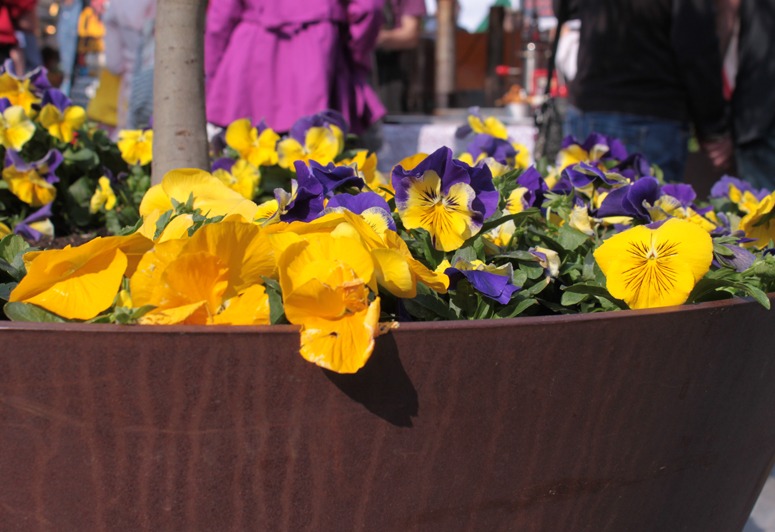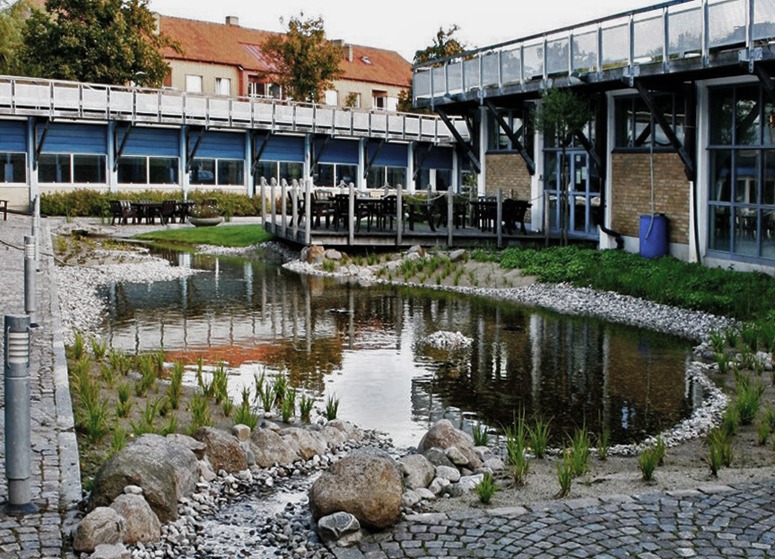‘Everyone has a wish’. Landscape architect Kendra Inman helped wishes grow on trees for the 2012 Chelsea Fringe. The labels (produced by school children, students and locals) were decorated to look like flowers and fruits. They were hung from trees at Dovehouse Green on the King’s Road in Chelsea, London as a contribution to the 2012 Chelsea Fringe. Kendra is a graduate of the MA Landscape Architecture at the University of Greenwich.
Category Archives: Garden Design
Floating Forest garden design for the 2012 Chelsea Fringe Festival
In rich soil, forest trees will flourish for a century, sheltering fauna and flora. Then they can serve humans for centuries to come. For the 2012 Chelsea Fringe, 600 discs of sliced pine forest have floated from Canada to London’s Portobello Dock. We welcome them.
The Floating Forest Garden was sponsored by Quebec’s Grand-Métis International Garden Festival (220 miles north of Quebec City). The festival is near Reford Gardens (Jardins de Métis) – which were founded by Elsie Reford. The garden design is by NIPpaysage – a group of Canadian landscape architects. They came together at the Université de Montréal (in 2001) and have received many awards.
The Dock Kitchen (Portobello Docks, 344/342 Ladbroke Grove, Kensal Road, London, W10 5BU) is Stevie Parle’s West London restaurant. It overlooks the Grand Union Canal and the Tom Dixon shop is also here.
What is the style of contemporary garden design and landscape architecture?
The M&G Garden, designed by Andy Sturgeon, would have received the Gardenvisit Award for ‘Best in Show‘, but for the designer’s crackpot explanation. Here is the Telegraph’s account of what he said: ‘The M&G Garden’ 2012, a ‘New English’ garden harking back to the Arts and Crafts movement, but with a modern-day twist. Featuring monolithic blocks of stone, a 98ft free-form ‘energy wave’ sculpture and a mix of formal, asymmetrical designs and informal cottage-garden planting, the garden truly reflects the values of M&G.’
Artists have been much better at naming styles and Wiki gives the following for the contemporary period:
Contemporary art – present
Toyism 1992 – present
Digital art 1990 – present
Postmodern art – present
Modernism – present
New realism 1960 –
Performance art – 1960s –
Fluxus – early 1960s – late-1970s
Conceptual art – 1960s –
Graffiti 1960s-
Junk art (adde) 1960s –
Psychedelic art early 1960s –
Lyrical Abstraction mid-1960s –
Process art mid-1960s – 1970s
Arte Povera 1967 –
Photorealism – Late 1960s – early 1970s
Land art – late-1960s – early 1970s
Post-minimalism late-1960s – 1970s
Installation art – 1970s –
Mail art – 1970s –
Neo-expressionism late 1970s –
Metarealism – 1970 -1980, Russia
Figuration Libre early 1980s
Metaphorical realism
Young British Artists 1988 –
Rectoversion 1991 –
Transgressive art
Synaesthesia events
Neoism 1979
Deconstructivism
Battle Elephants 1984
Massurrealism 1992 –
Stuckism 1999 –
Remodernism 1999 –
Maximalism
ArT is free 2010-
Would any of these fit Andy Sturgeon’s garden? Well ‘postmodern’ certainly would. Readers are invited to suggest classifications.
‘Classifying Andy’ is part of a wider problem: are garden designers and landscape architects totally lacking style?
Garden of Disorientation: design for the 2012 Chelsea Fringe Festival
‘Smithfield is renowned for the ghostly late-night movement of animal carcasses and more recently for the early-morning traffic of displaced revelers. Adding to the mix is this new internal garden space, the Garden of Disorientation’. I went to visit the garden on a really hot day in the course of a long cycle ride to visit other Chelsea Fringe projects. Suffering from heat disorientation, I found this intriguing space blessed me with orientation, as did a delicious drink. Deborah Nagan, of naganJohnson, designed the Garden of Disorientation for the 2012 Chelsea Fringe. The Garden of Disorientation is at 59 Charterhouse Street, Smithfield, London, EC1M from 19th May to 10 June 2012. Deborah is a graduate of the MA Landscape Architecture at the University of Greenwich. The Modern Garden Company was the main sponsor and supplied the excellent garden furniture: it is tough, stylish and street-worthy.
There are lots of reasons for wishing the Chelsea Fringe every success: it makes London an even more exciting city; it confirms London’s role as the world’s garden capital; it creates opportunities for landscape architects to show what wonderful things they can do for the city; it lets sponsors do really good things with their marketing budgets. We have many helpful suggestions!
So COME ON EVERYONE: the Chelsea Fringe has 100 projects in 2012: LETS MAKE IT 1000 PROJECTS IN 2013. Anyone unlucky enough not to be in London from 19th May to 10th June 2012 can do the London Gardens Walk. It is open on every day of every year.
Corten steel garden planters
Iron is the fourth most common element in the Earth’s crust and, by mass, the most common element. It is a wonderful material, famed for its strength and mystery. Iron oxides give soils their red and yellow hues. They are nature’s foil to the often-garish colours of flowers and vivid greens of foliage. But gardeners associate iron with one of their enemies (rust) and coat it with expensive paints. Instead, they should learn to love the rich colours of iron oxide on Corten Steel.
Wrought iron has a low carbon content. Mild steel has a higher carbon content. Cast iron has an even higher carbon content (above 2.1%). Corten steel (patented as Cor-Ten) is an alloy of mild steel with copper and chromium. It oxidises to create a protective outer layer which stops corosion: it rusts a little and rusts no more. One can therefore enjoy the beauty of the iron oxide without worrying about the rusting destroying the steel. Having all the tensile strengh of steel, Corten garden planters are completely frost resistent and impact resistent. Since they are not mass produced, they can be supplied to order (eg by Crinklecrankle.com in the UK).
See also: corten steel in garden and landscape design
MOER Green roofs: history, classification and naming
This blog has often discussed green roofs and green roof typologies but they always need more consideration:
Green roofs c3500BC
Turf was the standard roofing material in Neolithic North Europe. You can still see this roofing technique in Norway and Iceland
Roof garden c1000BC
The most famous elevated garden in history, the Hanging Gardens of Babylon, may not have been on a roof. Nothing is known about the construction and they may have been ‘hanging’ on an embankment rather then a roof. But they were definitely used as a garden and the only illustration of this type of space is a carved tablet in the British Museum. This was a place for fruits and flowers and a place to walk in the cool of the evening
Roof gardens in the twentieth century
Cities were becoming much denser and much higher-rise, so people began making modern roof gardens. Corbusier proposed one in Paris and the landscape architect, Ralph Hancock, designed one for Derry and Toms, now called the Kensington Roof Garden
Green roofs in the twentieth century
People began to remember that ‘green stuff’ could also serve as a roof-covering material and then found many reasons for reviving the idea: water conservation, biodiversity, acoustics, insulation etc. This led to the making of what are called ‘extensive’ green roofs and, by way of contrast, roof ‘gardens’ came to be called ‘extensive’ green roofs. I think the terminology began in Germany.
Moer Roofs in the twenty-first century
The City of Malmö and the Scandinavian Green Roof institute established a 9000m3 green roof which is called the Augustenborg Botanical Roof Garden. It is a good project and, though the name suggests ‘a botanical garden on a roof’, the design objectives of the Malmö roof are broad: ‘environmental, economical, and to improve storm water management, health and aesthetics in our communities’. This type of roof needs a new name and we could base it on MOER technology: Multi-Objective Environmental Roofing (pronounced as ‘mower’, for irony). The roles of a broad spectrum Moer Roof would include: social use, aesthetic use, food production use (including aquaponics), water conservation, biodiversity, acoustics, insulation, energy generation, sustainability etc. The SGRA has a useful classification of green roof advantages and design objectives
Image courtesy i-sustain



